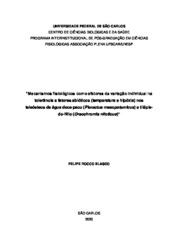Mostrar el registro sencillo del ítem
Mecanismos fisiológicos como efetores da variação individual na tolerância a fatores abióticos (temperatura e hipóxia) nos teleósteos de água doce pacu (Piaractus mesopotamicus) e tilápia-do-Nilo (Oreochromis niloticus)
| dc.contributor.author | Blasco, Felipe Rocco | |
| dc.date.accessioned | 2021-06-22T21:50:57Z | |
| dc.date.available | 2021-06-22T21:50:57Z | |
| dc.date.issued | 2020-12-14 | |
| dc.identifier.citation | BLASCO, Felipe Rocco. Mecanismos fisiológicos como efetores da variação individual na tolerância a fatores abióticos (temperatura e hipóxia) nos teleósteos de água doce pacu (Piaractus mesopotamicus) e tilápia-do-Nilo (Oreochromis niloticus). 2020. Tese (Doutorado em Ciências Fisiológicas) – Universidade Federal de São Carlos, São Carlos, 2020. Disponível em: https://repositorio.ufscar.br/handle/ufscar/14408. | * |
| dc.identifier.uri | https://repositorio.ufscar.br/handle/ufscar/14408 | |
| dc.description.abstract | The anthropic influence on the aquatic environment will be responsible for an increase in the frequency and intensity of exposure of fish to two very important stressors in the viability of these animals: temperature and hypoxia. Temperature is already well established as the main abiotic factor to influence the viability of ectothermic animals. Due of the efficient heat exchange that takes place between the branchial epithelium and the body surface with the surrounding environment and the relative low heat production by these animals, usually the ambient temperature will dictate the body temperature, which will inevitably influence the metabolic rate. Hypoxia has the characteristic of limiting the availability of oxygen (O2) for the performance of essential functions for the maintenance of life, as well as for the performance of activities that would ensure greater evolutionary success and fitness of the animals to the environment in which they live. Considering that both stressors are related to the availability and consumption of O2, the study of the three variables that comprise an individual's aerobic metabolic phenotype (standard metabolic rate - SMR; active metabolic rate – AMR and aerobic scope - AS) has proved to be an efficient tool in order to better understand the mechanisms related to individual variation in tolerance to such stressors. Using as experimental models two abundant species in the Brazilian ichthyofauna, Nile-tilapia (Oreochromis niloticus) and pacu (Piaractus mesopotamicus), we studied whether the premises mentioned are related to tolerance. In experiment 1 we developed a new protocol to test the acute heating tolerance (CTswim). Such test aims to be an ecologically more relevant alternative and whose factors associated with the tolerated thermal limit are well understood, different from the current CTmax test. For both studied species, CTswim was approximately 2ºC lower than CTmax. In addition, the fatigue presented during the heated swimming protocol proved to be an interesting “endpoint” since this behavior was preceded by the adoption of an anaerobic swimming profile. This fact leads us to believe in an inability to provide O2 to the tissues in operation, indicating that the viability of the animals is possibly compromised at temperatures lower than those reported by CTmax. In experiment 2, using pacu as an experimental species, we investigated the correlation between the individual metabolic phenotype and the tolerance to acute heating and hypoxia, in addition to trying to discover a possible cross-tolerance between both stressors. The tolerance to acute heating was measured using the protocols CTswim and CTmax and the tolerance to hypoxia was measured using the Scrit calculation, that is, the O2 saturation in the water in which the animal loses the ability to oxirregulate. We found that the tolerance to acute heating, in both protocols, was not dependent upon the metabolic phenotype of the individuals, as well as the tolerance to hypoxia was not dependent upon SMR. Regarding the cross tolerance between stressors, we found a correlation between tolerance to hypoxia and CTswim, in line with the founds from our previous study about the importance of O2 supply in this new thermal tolerance test. In experiment 3, we studied the hypothesis that states that individuals of greater mass are more susceptible to heating due to limitations in the ability to provide O2 for aerobic activities. With this aim we used individuals of Nile-tilapia that varied by more than one order of magnitude in body mass and exposed them to the CTmax and CTswim tests. We found that the AS calculated at the acclimatization temperature had no correlation with the animal's body mass, as well as for thermal tolerance at CTmax. However, the acute heating tolerance in the CTswim proved to be inversely proportional to the animal's mass, as well as the MMR calculated during the test. Such findings show us that when exposed to acute warming, bigger animals have their ability to swim impaired at lower temperatures than the conspecifics smaller ones. This character can come to hinder the survival and fitness of these individuals in a scenario where such situations may be more frequent. | eng |
| dc.description.sponsorship | Coordenação de Aperfeiçoamento de Pessoal de Nível Superior (CAPES) | por |
| dc.language.iso | por | por |
| dc.publisher | Universidade Federal de São Carlos | por |
| dc.rights | Attribution-NonCommercial-NoDerivs 3.0 Brazil | * |
| dc.rights.uri | http://creativecommons.org/licenses/by-nc-nd/3.0/br/ | * |
| dc.subject | Variabilidade individual | por |
| dc.subject | Fenótipo metabólico | por |
| dc.subject | Estressores ambientais | por |
| dc.subject | Ecofisiologia | por |
| dc.subject | Fisiologia cardiorrespiratória | por |
| dc.title | Mecanismos fisiológicos como efetores da variação individual na tolerância a fatores abióticos (temperatura e hipóxia) nos teleósteos de água doce pacu (Piaractus mesopotamicus) e tilápia-do-Nilo (Oreochromis niloticus) | por |
| dc.title.alternative | Physiological mechanisms as effectors of individual variation in tolerance to abiotic factors (temperature and hypoxia) in freshwater teleosts pacu (Piaractus mesopotamicus) and Nile tilapia (Oreochromis niloticus) | eng |
| dc.type | Tese | por |
| dc.contributor.advisor1 | Rantin, Francisco Tadeu | |
| dc.contributor.advisor1Lattes | http://lattes.cnpq.br/3546242299713690 | por |
| dc.description.resumo | A influência antrópica no ambiente aquático será responsável por um aumento na frequência e intensidade de exposição dos peixes a dois agentes estressores muito importantes na viabilidade desses animais: temperatura e hipóxia. A temperatura já é bem estabelecida como o principal fator abiótico a influenciar na viabilidade dos animais ectotérmicos. Por conta da eficiente troca de calor que acontece entre o epitélio branquial e a superfície corpórea com o ambiente que os circundam e a relativa baixa produção de calor por esses animais, usualmente a temperatura ambiental irá ditar a temperatura corpórea, o que inevitavelmente irá influenciar na taxa metabólica. A hipóxia tem por característica limitar a disponibilidade de oxigênio (O2) para a realização das funções essenciais para a manutenção da vida, bem como para a realização de atividades que assegurariam um maior sucesso evolutivo e aptidão dos animais ao ambiente em que vivem. Considerando que ambos estressores estão relacionados à disponibilidade e consumo de O2, o estudo das três variáveis que compreendem o fenótipo metabólico aeróbico de um indivíduo (taxa metabólica padrão – TMP; taxa metabólica ativa – TMA e aumento aeróbico – AA) tem se mostrado uma ferramenta eficiente a fim de compreender os mecanismos relacionados à variação individual na tolerância a tais estressores. Usando como modelos experimentais duas espécies abundantes na ictiofauna brasileira, tilápia-do-Nilo (Oreochromis niloticus) e pacu (Piaractus mesopotamicus), estudamos se as premissas citadas estão relacionadas à tolerância. No experimento I desenvolvemos um novo protocolo para testar a tolerância ao aquecimento agudo (CTswim). Tal teste visa ser uma alternativa ecologicamente mais relevante e cujos fatores associados ao limite térmico tolerado sejam bem compreendidos, diferente do atual teste CTmax. Para ambas as espécies estudadas, o CTswim foi aproximadamente 2ºC menor do que o CTmax. Além disso, a fadiga apresentada durante o protocolo de natação aquecida se mostrou um interessante “endpoint” uma vez que esse comportamento foi precedido pela adoção de um perfil anaeróbico de natação. Tal fato nos leva a acreditar em uma inabilidade em prover O2 aos tecidos em funcionamento, indicando que a viabilidade dos animais é possivelmente comprometida a temperaturas menores das reportadas pelo CTmax. No experimento II, utilizando o pacu como espécie experimental, investigamos a correlação entre o fenótipo metabólico individual e a tolerância ao aquecimento agudo e à hipóxia, além de tentar descobrir uma possível tolerância cruzada entre ambos estressores. A tolerância ao aquecimento agudo foi medida por meio dos protocolos CTswim e CTmax e a tolerância à hipóxia foi medida por meio do cálculo do Scrit, ou seja, a saturação de O2 na água na qual o animal perde a habilidade em oxirregular. Encontramos que a tolerância ao aquecimento agudo, em ambos os protocolos, não foi dependente do fenótipo metabólico dos indivíduos, bem como a tolerância à hipóxia não foi dependente da TMM. Em relação à tolerância cruzada entre os estressores, encontramos correlação entre tolerância à hipóxia e CTswim, indo ao encontro do estudo anterior sobre a importância no suprimento de O2 nesse novo teste de tolerância térmica. No experimento III estudamos a hipótese que afirma que os indivíduos de maior massa são os mais suscetíveis ao aquecimento devido a limitações na capacidade em prover O2 para as atividades aeróbicas. Para isso usamos exemplares de tilápia-do-Nilo que variaram em mais de uma ordem de magnitude na massa corporal e os expusemos aos testes CTmax e CTswim. Encontramos que o AA calculado na temperatura de aclimatação não teve correlação com a massa corpórea do animal, assim como a tolerância térmica no CTmax. Entretanto a tolerância ao aquecimento agudo no CTswim se mostrou inversamente proporcional à massa do animal, bem como a TMM calculada durante o teste. Tais achados nos mostram que quando expostos ao aquecimento agudo, os animais maiores têm a sua habilidade em nadar prejudicada a temperaturas inferiores do que os animais menores. Esse caráter pode vir a atrapalhar a sobrevivência e aptidão desses indivíduos em um cenário onde tais situações poderão ser mais frequentes. | por |
| dc.publisher.initials | UFSCar | por |
| dc.publisher.program | Programa Interinstitucional de Pós-Graduação em Ciências Fisiológicas - PIPGCF | por |
| dc.subject.cnpq | CIENCIAS BIOLOGICAS::FISIOLOGIA | por |
| dc.subject.cnpq | CIENCIAS BIOLOGICAS::FISIOLOGIA::FISIOLOGIA DE ORGAOS E SISTEMAS::FISIOLOGIA CARDIOVASCULAR | por |
| dc.subject.cnpq | CIENCIAS BIOLOGICAS::FISIOLOGIA::FISIOLOGIA COMPARADA | por |
| dc.description.sponsorshipId | CAPES: Código de Financiamento 001 | por |
| dc.publisher.address | Câmpus São Carlos | por |
| dc.contributor.authorlattes | http://lattes.cnpq.br/6314781191230873 | por |


